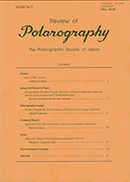
- Issue 2 Pages 57-
- Issue 1 Pages 1-
- |<
- <
- 1
- >
- >|
-
Toshiyuki Osakai2018Volume 64Issue 1 Pages 1-2
Published: May 08, 2018
Released on J-STAGE: May 23, 2018
JOURNAL FREE ACCESSDownload PDF (229K)
-
Ryoichi Ishimatsu, Hirosato Shintaku2018Volume 64Issue 1 Pages 3-10
Published: May 08, 2018
Released on J-STAGE: May 23, 2018
JOURNAL FREE ACCESSElectrogenerated Chemiluminescence (ECL) involves electrode reactions and the following homogeneous electron transfer reactions which resulted in a light emission. In this integrated research paper, we focused on the homogeneous electron transfer reactions to form excited states of some luminescent molecules. The Marcus theory was used to estimate ratios of the electron-transfer rate constants between a radical cation and anion to generate the lowest excited singlet and triplet states. In addition, the ECL behavior using tripropylamine as a coreactant was demonstrated by simulating the electrochemical and homogeneous electron transfer reactions with a finite element method. Although coreactants are useful to form excited species, because of complicated reactions in bulk, analyzing the ECL response such as relationship between the current-voltage and ECL intensity curves depending on the redox potentials of luminescent molecules and coreactants is quite difficult. It was shown that the simulations were very useful to understand the ECL response depending on the redox potentials of the coreactant and luminescent molecules.
View full abstractDownload PDF (713K)
-
Takashi Kakiuchi2018Volume 64Issue 1 Pages 11-18
Published: May 08, 2018
Released on J-STAGE: May 23, 2018
JOURNAL FREE ACCESSThe article W. Nernst published in 1892, entitled “Über die Löslichkeit von Mischkrystallen,” (On the solubility of mixed crystals), Z. phys. Chem., 9, 137-142 (1892), deserves to be cited as the original paper reporting the so-called Nernst equation for the ion-partitioning between the two immiscible electrolyte solutions. However, Nernst did not present the equation for the distribution potential across the interface emerged after equilibrium partitioning of all the ions present in the system, though claimed to be derivable with ease. The absence of a clear distinction between the systems having different degrees of freedom, i.e., a two phase system consisting of two immiscible electrolyte solutions and that of an aqueous electrolyte solution saturated with two sparingly soluble solid salts, precludes the derivation of an appropriate expression for the distribution potential. The equation of the distribution potential that appropriately describes the latter case has been derived. The practical range capability of his idea is thus next to zero, while Roozeboom's article published in 1891 has a much longer range capability to date, when the mixtures of two hydrophobic ionic liquids have been of contemporary significance and interest.
View full abstractDownload PDF (699K)
-
Hajime KATANO2018Volume 64Issue 1 Pages 19-25
Published: May 08, 2018
Released on J-STAGE: May 23, 2018
JOURNAL FREE ACCESSThis technical note describes electrical circuits to utilize a commercially available microcontroller, Arduino Due, in voltammetric measurements. The microcontroller is equipped with analog input/output and serial communications interfaces. Through a suitable voltage conversion circuit, the analog output becomes usable as a signal source for the external input in potentiostat. Similarly, the external output signal from potentiostat can be inputted to the analog input. This note also describes a potentiostat circuit for the microcontroller. A compact and lightweight voltammetry instrument can be inexpensively fabricated.
View full abstractDownload PDF (782K)
-
Masahiro Yamamoto2018Volume 64Issue 1 Pages 27-33
Published: May 08, 2018
Released on J-STAGE: May 23, 2018
JOURNAL FREE ACCESSDownload PDF (490K)
-
[in Japanese]2018Volume 64Issue 1 Pages 35
Published: May 08, 2018
Released on J-STAGE: May 23, 2018
JOURNAL FREE ACCESSDownload PDF (287K)
- |<
- <
- 1
- >
- >|